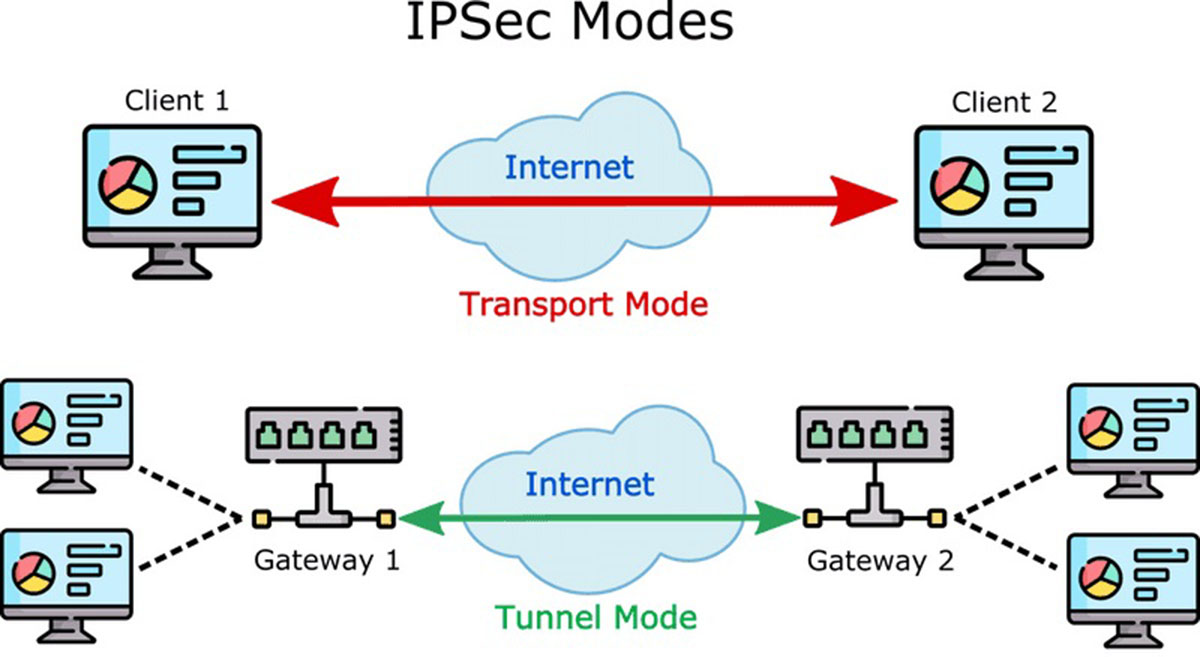Introduction
In today’s interconnected world, with the increasing dependence on the internet for various activities such as communication, financial transactions, and data sharing, the need for robust security measures has become more critical than ever. With cyber threats and hacking incidents on the rise, it’s essential to protect sensitive information from unauthorized access and ensure secure data transmission.
This is where IPsec (Internet Protocol Security) steps in as a reliable and widely used framework for securing internet communications. IPsec provides a comprehensive set of protocols and algorithms that protect the confidentiality, integrity, and authenticity of data transferred over IP networks.
Whether you’re a business owner, a network administrator, or an individual concerned about online security, understanding the basics of IPsec is crucial. In this article, we will delve into the fundamentals of IPsec, its working mechanism, components, and its benefits and limitations.
IPsec operates at the network layer of the OSI model and can be implemented in various network architectures, including virtual private networks (VPNs) and site-to-site connections. By encrypting and authenticating IP packets, IPsec ensures that data transmitted between two endpoints remains secure and protected from unauthorized interception or tampering.
By establishing secure and authenticated channels between network devices or endpoints, IPsec forms the bedrock for secure data transmission. It provides a reliable mechanism to safeguard information across public networks like the internet, making it an integral part of modern communication infrastructure.
Now that we have a general understanding of why IPsec is essential, let’s delve deeper into how this ingenious security framework works and the different components that make it possible.
What is IPsec?
IPsec, short for Internet Protocol Security, is a framework that provides a secure means of transmitting data over IP networks. It ensures that the information exchanged between network devices remains confidential, intact, and authenticated.
IPsec operates primarily at the network layer of the OSI model, enabling secure communication between two endpoints. It can be used to secure various types of network connections, including remote access VPNs, site-to-site VPNs, and even individual application traffic.
The core functionality of IPsec lies in its ability to encrypt and authenticate IP packets. Encryption ensures that the data transmitted between endpoints is encoded and can only be deciphered by authorized recipients, protecting it from unauthorized access. Authentication, on the other hand, verifies the identity of the communicating parties, ensuring that the data is not tampered with or intercepted by malicious entities.
IPsec achieves its objectives through a combination of security protocols, algorithms, and mechanisms. These include:
- Authentication Header (AH): Provides data integrity and authentication.
- Encapsulating Security Payload (ESP): Offers confidentiality, integrity, and authentication.
- Internet Key Exchange (IKE): Establishes a secure, authenticated channel and negotiates encryption parameters between IPsec peers.
- Security Associations (SAs): Define the parameters and attributes needed for secure communication.
IPsec ensures the secure transmission of data by creating a virtual tunnel between the communicating endpoints. This tunnel encapsulates the original IP packets and applies encryption, authentication, or both, based on the chosen IPsec mode.
Overall, IPsec provides a robust and effective solution for securing data transmitted over IP networks. Its versatility, compatibility, and wide support across various operating systems and devices make it a popular choice for organizations and individuals seeking to safeguard their sensitive information.
Now that we understand what IPsec is at a high level, let’s explore how it actually works and the different components that make it all possible.
How does IPsec work?
IPsec works by implementing a set of security protocols and algorithms that provide secure authentication, encryption, and data integrity for IP communications. It operates at the network layer of the OSI model and can be deployed in various network architectures to ensure the confidentiality and integrity of transmitted data.
At its core, IPsec works by establishing secure connections, referred to as Security Associations (SAs), between two endpoints. These endpoints can be network devices, such as routers or firewalls, or individual hosts, such as computers or mobile devices. IPsec employs two primary protocols, Authentication Header (AH) and Encapsulating Security Payload (ESP), to provide the necessary security services.
The process of establishing a secure communication channel using IPsec typically involves the following steps:
- Security Policy Database (SPD) Configuration: A security policy database is created on the IPsec-enabled devices to define the security policies for traffic that should be protected. These policies determine which traffic should be secured and specify the parameters required for encryption, authentication, and integrity protection.
- Security Association Database (SAD) Configuration: A security association database is set up on the IPsec peers to store information about the negotiated security parameters, including keys and algorithms, for the secure communication.
- Key Exchange and Negotiation: The IPsec peers perform a key exchange using the Internet Key Exchange (IKE) protocol. IKE establishes a secure channel and negotiates the encryption and authentication parameters. It ensures that the IPsec peers can securely authenticate each other and securely distribute the encryption keys used for data protection.
- Secure Communication: Once the key exchange is complete and the SAs are established, the IPsec-enabled devices can securely communicate by encapsulating the IP packets with either the AH or ESP headers. AH provides authentication and integrity protection, while ESP offers confidentiality, authentication, and integrity protection. The choice of which header to use depends on the desired security goals and the IPsec mode selected.
IPsec can operate in two main modes: transport mode and tunnel mode. In transport mode, the IP payload is encrypted and authenticated, while the IP header remains intact. This mode is typically used for securing host-to-host communication within a network. In tunnel mode, the entire IP packet, including the original IP header, is encapsulated and encrypted. This mode is commonly used for securing network-to-network or remote access VPN connections.
By employing these mechanisms and protocols, IPsec ensures that the data transmitted over IP networks is protected from unauthorized access and tampering, providing a secure and reliable solution for maintaining the confidentiality of sensitive information.
Now that we’ve explored how IPsec works, let’s dive into the various components involved in the IPsec framework.
IPsec Components
IPsec consists of several key components that work together to provide secure communication over IP networks. These components play a crucial role in establishing and maintaining the security of IPsec-enabled connections. Let’s take a closer look at each of these components:
- Security Policy Database (SPD): The Security Policy Database contains a set of rules that determine which traffic should be protected by IPsec. These rules define the source and destination IP addresses, protocols, and port numbers that should be subject to IPsec processing.
- Security Association Database (SAD): The Security Association Database stores the parameters associated with each established Security Association (SA). SAs are used to secure the communication between IPsec peers, and the SAD holds information about the security parameters, including encryption keys, authentication methods, and lifetime policies.
- Internet Key Exchange (IKE): IKE is a protocol used to negotiate IPsec security associations between two peers. It establishes a secure channel for exchanging encryption keys and authentication information required for secure communication. IKE also provides the framework for key management, ensuring that the keys shared between IPsec peers are secure and up-to-date.
- Security Associations (SAs): A Security Association is a unidirectional relationship established between IPsec peers. It defines the security parameters, such as encryption algorithm, authentication method, and keying material, for securing the communication between the peers. Each SA is uniquely identified by a Security Parameter Index (SPI).
- Authentication Header (AH): AH is an IPsec protocol used to provide authentication and integrity protection for IP packets. It verifies the authenticity of the packet and detects any modifications or tampering attempts during transit. AH does not provide encryption, but it ensures that the packet contents remain intact.
- Encapsulating Security Payload (ESP): ESP is an IPsec protocol that offers confidentiality, authentication, and integrity protection for IP packets. It encapsulates the original IP packet, providing encryption to maintain data confidentiality, authentication to ensure packet authenticity, and integrity checks to detect any alterations or tampering.
These components work together to form a robust framework for securing IP communications. By leveraging the security policies, security associations, encryption algorithms, and authentication mechanisms, IPsec establishes secure channels and protects the confidentiality, integrity, and authenticity of data transmitted over IP networks.
Now that we have a good understanding of the IPsec components, let’s explore the concept of Security Associations in more detail.
Security Associations
The concept of Security Associations (SAs) is fundamental to the operation of IPsec. A Security Association is a unidirectional relationship established between IPsec peers to secure the communication between them. Each SA defines the security parameters that will be used for protecting the data exchanged between the peers.
When two IPsec-enabled devices, such as routers or firewalls, establish a secure connection, they negotiate and agree upon the parameters of the SA. These parameters include encryption algorithm, authentication method, lifetime policies, and keying material. The negotiation process is facilitated by the Internet Key Exchange (IKE) protocol, which ensures that the peers can securely authenticate each other and securely exchange the required security parameters.
Each SA is uniquely identified by a Security Parameter Index (SPI), which allows the IPsec peers to differentiate between multiple SAs. The combination of the SPI and the IP destination address uniquely identifies an SA. This allows the IPsec devices to determine which SA to use for processing incoming traffic.
There are two types of SAs in IPsec:
- Inbound SA: An inbound SA is applied to the incoming traffic received by an IPsec device. It is used to decrypt, authenticate, and verify the integrity of the received packets. The device uses the SA parameters, such as the encryption algorithm and authentication method, to process the incoming traffic accordingly.
- Outbound SA: An outbound SA is applied to the outgoing traffic sent by an IPsec device. It is used to encrypt, authenticate, and ensure the integrity of the packets before they are transmitted. The device uses the SA parameters to encapsulate the outgoing packets and apply the necessary encryption and authentication mechanisms.
Each IPsec peer maintains a Security Association Database (SAD), which stores information about the negotiated SAs. The SAD holds the SA parameters, such as the SPI, encryption keys, authentication methods, and lifetime policies. This database allows the IPsec device to look up the appropriate SA when processing incoming or outgoing traffic.
Multiple SAs can exist simultaneously between two IPsec peers. This can occur when there are different security policies or when multiple tunnels or connections are established between the devices. The presence of multiple SAs allows for flexible and granular control over the secure communication between the peers.
By establishing and maintaining SAs, IPsec ensures that the data exchanged between IPsec peers is encrypted, authenticated, and protected from unauthorized access or tampering. The use of SAs helps to enforce security policies, facilitate secure communication, and provide a reliable framework for maintaining the confidentiality and integrity of transmitted data.
Now that we have explored Security Associations, let’s delve into the different IPsec modes used to secure IP communications.
IPsec Modes
In IPsec, there are two main modes of operation: transport mode and tunnel mode. These modes determine how the IP packets are protected and encapsulated when using IPsec to establish secure communication between two endpoints.
1. Transport Mode:
In transport mode, IPsec protects the payload of the IP packet while leaving the original IP header intact. This mode is typically used for securing host-to-host communication within a network. Transport mode provides end-to-end security between the source and destination IP addresses.
When using transport mode, the IP payload is encrypted and authenticated, ensuring that the data remains confidential and cannot be tampered with during transmission. The original IP header is used to route the encrypted packet to the destination, providing the necessary addressing information for proper delivery.
2. Tunnel Mode:
In tunnel mode, the entire IP packet, including the original IP header, is encapsulated and encrypted. This mode is commonly used for securing network-to-network or remote access VPN connections. Tunnel mode allows for secure communication between different networks, regardless of the underlying infrastructure.
When using tunnel mode, the original IP packet is encapsulated within a new IP packet. The new IP header contains the addressing information needed to route the protected packet to the destination. The encapsulated packet is then encrypted and authenticated, ensuring confidentiality and integrity of the entire packet.
Tunnel mode provides an additional layer of security by hiding the original source and destination IP addresses from potential eavesdroppers. This helps to protect the privacy and confidentiality of the communicating parties.
Both transport mode and tunnel mode offer advantages and are used in different scenarios depending on the specific requirements. The choice between them depends on factors such as the level of security needed, the network architecture, and the nature of the communication.
It’s important to note that regardless of the mode selected, IPsec ensures the encrypted and authenticated transmission of data between the IPsec peers. Whether it’s securing individual host-to-host communication or establishing secure network connections, IPsec provides a versatile and reliable framework for protecting IP communications.
Now that we have explored the different modes of IPsec operation, let’s delve into the specific protocols used by IPsec to provide its security services.
IPsec Protocols
IPsec utilizes several protocols to provide the necessary security services for protecting IP communications. These protocols work together to ensure confidentiality, integrity, and authenticity of data exchanged between IPsec peers.
Let’s take a closer look at the key IPsec protocols:
- Authentication Header (AH): AH is an IPsec protocol that provides authentication and integrity protection for IP packets. It adds an authentication header to the IP packet, which contains a hash value computed over the packet’s contents and a secret key shared between the IPsec peers. AH verifies the authenticity of the packet and detects any modifications or tampering attempts during transit. However, AH does not provide confidentiality, as the packet contents are left in plaintext.
- Encapsulating Security Payload (ESP): ESP is an IPsec protocol that offers confidentiality, authentication, and integrity protection for IP packets. It encapsulates the original IP payload and adds a new ESP header, which contains the necessary security parameters, including encryption keys, authentication information, and initialization vectors. ESP provides encryption to maintain data confidentiality, authentication to ensure packet authenticity, and integrity checks to detect any alterations or tampering during transit.
- Internet Key Exchange (IKE): IKE is a key management protocol used to establish and manage the security associations (SAs) between IPsec peers. IKE facilitates the secure exchange of encryption keys, authentication credentials, and negotiation of security parameters. It ensures that the IPsec peers can securely authenticate each other and establish a secure channel for further communication. IKE helps to simplify and automate the process of security association establishment, making it easier to manage large-scale IPsec deployments.
- Internet Security Association and Key Management Protocol (ISAKMP): ISAKMP is a protocol framework used by IKE to provide a consistent framework for key exchange and security association negotiation. It defines the format and exchange methods for messages used during the initial negotiations between IPsec peers. ISAKMP helps to ensure interoperability between different implementations of IPsec and facilitates the secure establishment of security associations.
These protocols work in conjunction to establish secure communication and protect the confidentiality, integrity, and authenticity of IP packets. AH and ESP provide the necessary security services, while IKE and ISAKMP handle key management, authentication, and negotiation of security parameters.
By leveraging these protocols, IPsec provides a robust framework for securing IP communications, whether it’s for remote access VPNs, site-to-site connections, or securing individual application traffic.
Now that we understand the key protocols used by IPsec, let’s explore the benefits and advantages that IPsec brings to secure communications.
Benefits and Advantages of IPsec
IPsec offers numerous benefits and advantages that make it a popular choice for securing IP communications. Let’s explore some of the key advantages of using IPsec:
- Enhanced Security: By encrypting and authenticating IP packets, IPsec provides robust security measures to protect the confidentiality, integrity, and authenticity of data transmitted over IP networks. It ensures that sensitive information remains secure and protected from unauthorized access or tampering.
- Flexibility and Compatibility: IPsec is widely supported across various operating systems, network devices, and platforms. It can be implemented in different network architectures, including remote access VPNs, site-to-site connections, and individual application traffic. This versatility and compatibility make IPsec a suitable choice for securing diverse network environments.
- Scalability: IPsec can be easily scaled to accommodate growing network infrastructure and evolving security requirements. From small-scale deployments to large enterprise networks, IPsec can handle various workloads and provide secure communication across geographically dispersed locations.
- Improved Performance: IPsec implementations have evolved to provide efficient processing and optimized performance. Advances in hardware acceleration, cryptographic algorithms, and protocol optimizations have minimized the impact on network throughput and latency. This ensures that the benefits of IPsec are achieved without significant performance degradation.
- Standards-based Approach: IPsec is based on established industry standards, ensuring interoperability between different vendors’ implementations. This allows organizations to choose from a wide range of compatible solutions and simplifies the integration of IPsec into existing network infrastructure.
- Comprehensive Security Services: IPsec offers a combination of encryption, authentication, and integrity protection to provide a holistic security solution for IP communications. It secures the data while in transit and ensures that the communication channels are authenticated and trusted. This comprehensive approach helps organizations meet compliance requirements and achieve a higher level of data protection.
- Cost-effective Solution: Implementing IPsec can be a cost-effective approach compared to other security solutions. As it is often built into networking equipment and operating systems, there is no need for additional hardware or software investments. Additionally, the use of open standards helps to avoid vendor lock-in and lowers the cost of maintenance and support.
Combined, these benefits and advantages make IPsec a powerful and reliable framework for securing IP communications. Whether it’s protecting sensitive data, establishing secure remote access connections, or ensuring the confidentiality of application traffic, IPsec provides the necessary security measures for organizations and individuals alike.
Now that we have explored the benefits of IPsec, let’s discuss some of its limitations and considerations.
Limitations of IPsec
While IPsec offers many advantages and is widely used for securing IP communications, it does have some limitations that organizations and individuals should consider. These limitations include:
- Complexity: IPsec can be complex to implement, configure, and manage, especially for non-technical users. It requires a good understanding of networking concepts, security protocols, and encryption algorithms. Improper configuration or management can lead to security vulnerabilities or connectivity issues.
- Performance Impact: Although advancements have been made in hardware acceleration and protocol optimizations, implementing IPsec can still introduce some performance overhead. The encryption and decryption processes can consume system resources and potentially impact network throughput and latency. Organizations need to consider the potential performance impact when deploying IPsec in high-bandwidth environments.
- End-to-End Security: IPsec provides security at the network layer, which means that it protects the communication between IPsec peers. However, it does not provide end-to-end security for the entire communication path. Other layers, such as the application layer, need to implement their own security measures to ensure comprehensive end-to-end security.
- Compatibility and Interoperability: While IPsec is based on industry standards, there can still be compatibility and interoperability challenges between different vendors’ implementations. Variations in implementation, configuration options, or support for specific cryptographic algorithms may create difficulties when establishing connections between IPsec peers. Careful consideration and testing are necessary when integrating IPsec into existing network infrastructure.
- Key Management: IPsec relies on robust key management to establish and maintain secure communication channels. Key management can be complex, especially in large-scale deployments that involve multiple IPsec peers. Ensuring secure key exchange, key generation, and key rotation require careful planning and implementation to avoid potential security risks.
- Single Point of Failure: In some deployment scenarios, IPsec implementations may introduce single points of failure that can impact network connectivity. If an IPsec gateway or device fails, it can disrupt the secure communication between IPsec peers. Organizations should consider redundancy and failover mechanisms to mitigate the risks associated with single points of failure.
Understanding these limitations and considerations is crucial for effectively implementing and managing IPsec. By addressing these challenges, organizations can make informed decisions and ensure that IPsec is deployed in a manner that aligns with their security requirements and operational needs.
Now that we are aware of the limitations of IPsec, let’s summarize the key points we’ve covered in this article.
Conclusion
In today’s digital landscape, where the security of data transmitted over IP networks is of utmost importance, IPsec emerges as a reliable and widely used framework for ensuring the confidentiality, integrity, and authenticity of IP communications.
IPsec operates at the network layer of the OSI model and leverages a combination of protocols, including Authentication Header (AH), Encapsulating Security Payload (ESP), Internet Key Exchange (IKE), and Internet Security Association and Key Management Protocol (ISAKMP), to establish secure communication channels and protect sensitive information.
IPsec offers several key benefits, including enhanced security, flexibility, scalability, improved performance, and compatibility with various operating systems and network devices. Its comprehensive security services, such as encryption, authentication, and integrity protection, make it a reliable choice for securing IP communications in different network architectures.
However, IPsec does have its limitations, including complexity in implementation and management, potential performance impact, the need for end-to-end security measures beyond IPsec, compatibility and interoperability challenges, key management complexities, and single points of failure in some deployment scenarios.
By carefully considering these advantages and limitations, organizations and individuals can make informed decisions regarding their use of IPsec. Proper planning, configuration, and ongoing management are crucial for ensuring the effective deployment of IPsec and addressing the specific security requirements of each environment.
In conclusion, IPsec provides a robust and reliable framework for securing IP communications, protecting sensitive information, and enabling organizations and individuals to transmit data over public networks with confidence. Understanding the concepts, components, and processes involved in IPsec is essential for leveraging its benefits while mitigating its limitations for a secure and resilient network infrastructure.

























